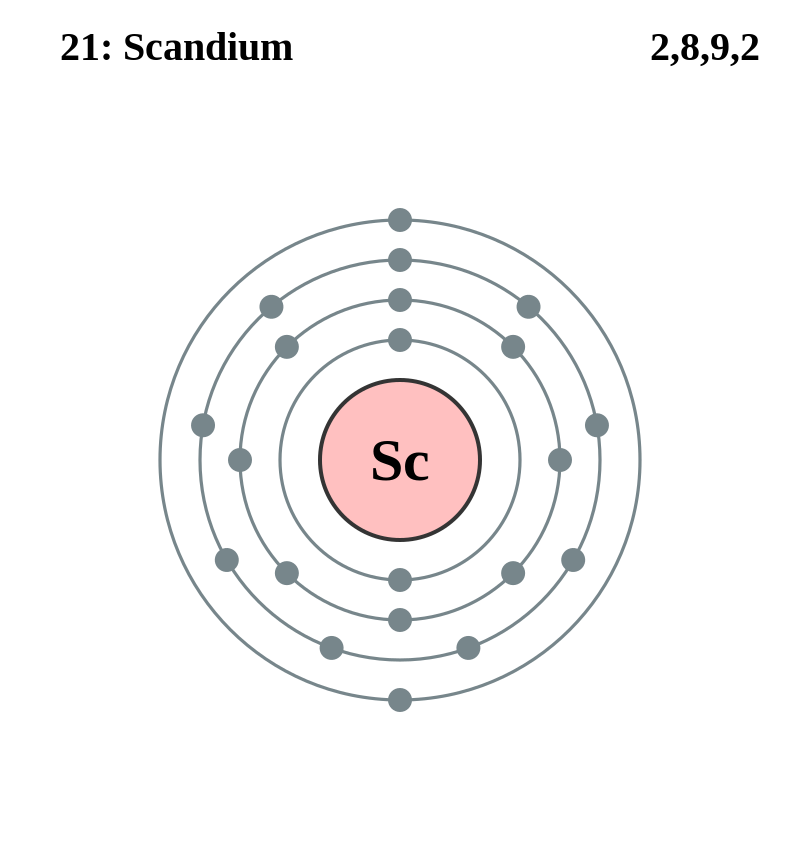
Introduction:
Scandium, a discreet element in the periodic table, boasts an intriguing profile with applications spanning diverse industries. This in-depth exploration aims to unravel the mysteries behind scandium by delving into its atomic structure, classification, and the distinctive features that set it apart in the world of elements.
Atomic Structure of Scandium:
Scandium, represented by the symbol Sc and positioned as the 21st element in the periodic table, unfolds its secrets through its atomic structure. With 21 protons and a variable number of neutrons in its nucleus, scandium’s electron configuration [Ar] 3d^1 4s^2 paints a vivid picture of its chemical reactivity and bonding capabilities.

Classification of Scandium:
Nestled in Group 3, sandwiched between calcium (Ca) and titanium (Ti), scandium’s dual classification as a transition metal and a rare earth element adds layers to its identity. These classifications highlight its ability to exhibit variable oxidation states, catalytic properties, and unique magnetic and luminescent attributes.
Unique Characteristics of Scandium:
- Lightweight Marvel: Scandium’s atomic mass of approximately 44.96 atomic mass units makes it notably lighter than its transition metal counterparts. This characteristic facilitates the formation of lightweight yet robust alloys, particularly when combined with aluminum, revolutionizing aerospace and sports equipment.
- Versatile Oxidation States: Scandium’s ability to adopt multiple oxidation states, predominantly +3, broadens its horizons in chemical reactions and materials synthesis. This versatility is pivotal in its role as a catalyst and contributes to the formation of diverse compounds.
- High Melting Point: With a higher melting point than many lightweight metals, scandium’s resilience in elevated temperatures enhances its suitability for applications in demanding environments, such as aerospace components subjected to extreme conditions.
- Magnetic Properties: While not as magnetic as some rare earth elements, scandium’s paramagnetism makes it responsive to magnetic fields. This property finds practical applications in magnetic resonance imaging (MRI) and magnetic alloys.
- Limited Natural Abundance: Scandium’s scarcity in Earth’s crust adds an element of challenge to its extraction and production. Despite its limited natural abundance, the growing demand for scandium underscores its unique properties and indispensable role in various applications.
Applications of Scandium:
- Aerospace Industry: Scandium-aluminum alloys revolutionize aerospace components, offering a balance of strength and lightweight properties. This innovation contributes to the development of more fuel-efficient and high-performance aircraft.
- Sports Equipment Manufacturing: Scandium’s application in sports equipment, from bicycle frames to baseball bats, stems from its contribution to lightweight yet durable alloys. Athletes benefit from the enhanced performance afforded by scandium-aluminum materials.
- Electronics and Semiconductor Technology: The electronics industry leverages scandium in semiconductor technology, contributing to the efficiency and miniaturization of electronic components. Its role in specific electronic devices underscores its impact on modern technology.
- Medical Imaging and Diagnostics: Scandium’s paramagnetic properties find a crucial role in medical imaging, particularly in the realm of MRI. Its presence enhances imaging quality, leading to more accurate diagnostic procedures.
- Solid Oxide Fuel Cells: In the pursuit of clean energy, scandium plays a vital role in solid oxide fuel cells. Its incorporation into fuel cell materials enhances performance, efficiency, and sustainability in energy generation.
Conclusion:
In the intricate tapestry of elements, scandium emerges as a distinctive thread, weaving its way through aerospace, sports, electronics, and clean energy. This exploration into its atomic structure, classification, and unique characteristics sheds light on the pivotal role scandium plays in shaping technological advancements. From its humble position in the periodic table, scandium stands tall as a catalyst for innovation, promising a future where its extraordinary properties continue to influence and redefine various industries.
Discover additional insights into scandium by visiting www.scandium.org.
Explore a wealth of information on other rare earth materials at www.stanfordmaterials.com.